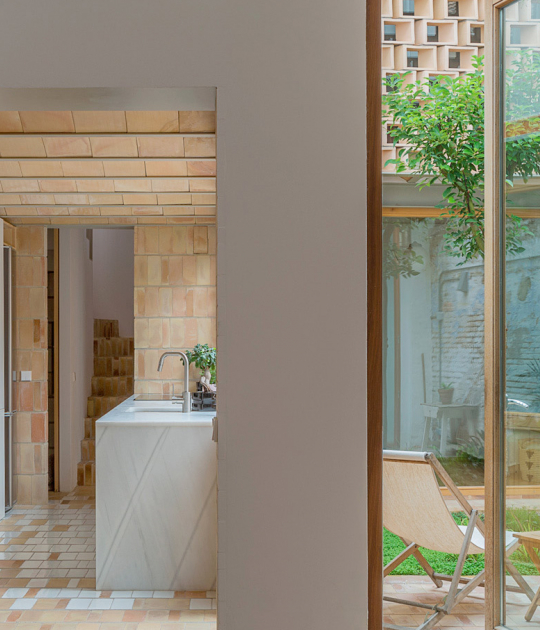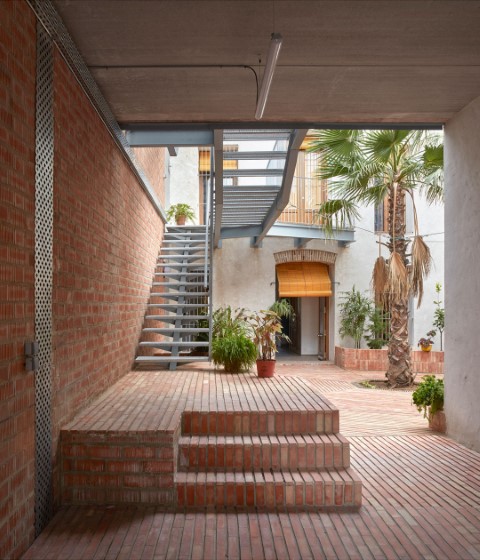Approaching from the street, it looks like a two-storey white house with a pergola. The acces descending a ramp or stairs to enter the house halfway down the slope. When you enter, find masonry vaults between the beams of steel skeleton, forming ceilings of shallow tile-brick arches. The vaults extend outside, covering porch areas.
The vaults technique reminiscent of works by Rafael Gustavino, architect Valencian, designer of many works in New York, after patented a “tile arch system” in the 1880s. From the interlocking herringbone ceiling of the oyster bar at Grand Central Station in New York to Carnegie Hall and Boston Public Library.
It is the first completed building by Space Popular. Yet Lesmes and Hellberg have designed a home with a lot of inventive in ways that are more than skin-deep. Brick Vault House was built in collaboration with local architects Estudio Alberto Burgos and Javier Cortina Maruenda.
Project description, abstract, by Space Popular
Brief
They wanted a house that was “different” but still fulfilled the usual expectations of a medium scale detached home. We suggested a grid system with which we could resolve the typical details that would allow them to create different configurations in the following houses, avoiding replication but still maintain some level of standardization.
The plot
The slope allowed us to create an arrival sequence through which the scale and features of the house are revealed progressively. The varying/shifting floor plates create a rich sequence of viewpoints, and therefore areas with very distinct visual character within the modular system. We think having a variety of spatial qualities and views around which to structure your daily life is an important value in medium and large homes. That the place where you sit in the morning for breakfast could have a different feel to where you spend your afternoon, or your summer vs. winter routines could make use of spaces differently configured, is something we strive for.
Material context
The house takes its cues from the materials and construction methods common in the area, both old -like the brick vaults- and new -such as the steel structure and the sandwich dry facade, which contractors are used to executing.
The grid
The space-frame is the structure of the building, together with the vaults. We wanted to create a unifying element between interior and exterior, as well as reveal the way the house is held up. We think one feels more at ease living in spaces where the way it all comes together can be easily discerned. The green blends with vegetation, works well against the sky and it is a colour that is often found in domestic interiors in small amounts, through plants. The steel grid is 10x10cm. The spacing is 3.75x3.75m and 3.16 height. The shifting of the floor plates was decided based on numerous solar analyses and layouts.
The vaults
The slabs are brick vaults, floating over the steel structure (which served as scaffolding during construction). The bricks are attached to one another by ensuring the gesso is at the right stage of drying when used so it sticks and bonds in the moment. This is an incredible advantage in their construction and although there are faster and more efficient slab construction methods today we think this system has a great combination of environmental materials and hand-craft. The geometry of the vaults creates a sense of expansion and lightness in the interiors.
Interior
The interior layout follows a typical medium-size home layout in the area today, expected number of rooms and types of spaces. Driving principles for us were to eliminate corridors by creating a central staircase and organizing rooms around it, to maintain the possibility to isolate spaces and provide expected privacy (possibility to separate kitchen from living room with sliding doors, provide privacy to bedroom + shared bathroom area, have a play/tv/leisure area separated from the main living room and connected to the pool area, have a quiet main living room space connected to upper covered terraces, and provide independent outdoor areas that different family members can use independently.
Finishes
We were not appointed to develop the interior design. The developer decided on standard affordable basic finishes. It was a challenge to figure out how to deliver spatial qualities that did not depend on finishes (especially since our previous projects are interiors for which we developed all finishes, fittings and furniture). We think it is important to be able to deliver what is required in each situation. Over that each tenant will overlay their taste through their furniture, carpets, curtains, things! perhaps even paint the walls, easily add awnings if they like, etc.
Furniture
The furniture pieces were kindly lent to us by Teulat for the photo shoot. As the house is to be rented or sold by the developer, we will not be able to access it -possibly ever again!- once a tenant moves in, therefore we wanted to have the chance to portray it with some furniture pieces within to show one way in which the house could be used. We brought as many things as we could from our home for the photo shoot, but of course it lacks the true life the tenants will bring. It is not easy to portray a good mess! This cannot be designed...




















































